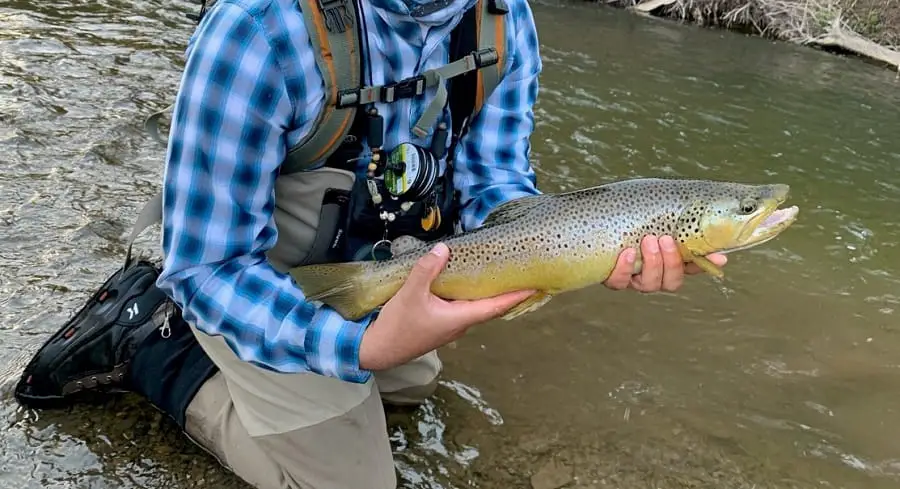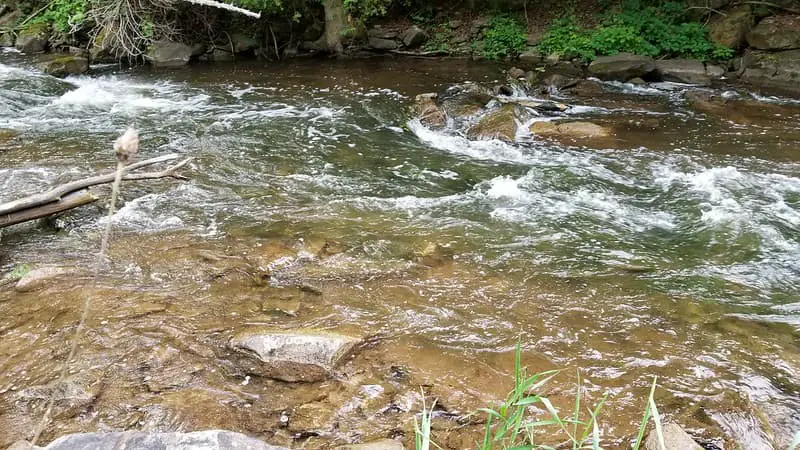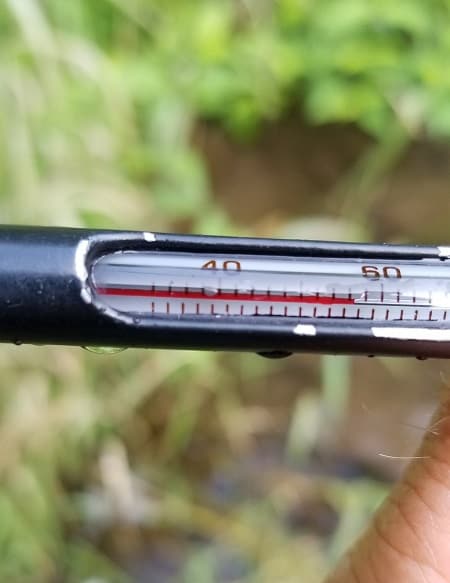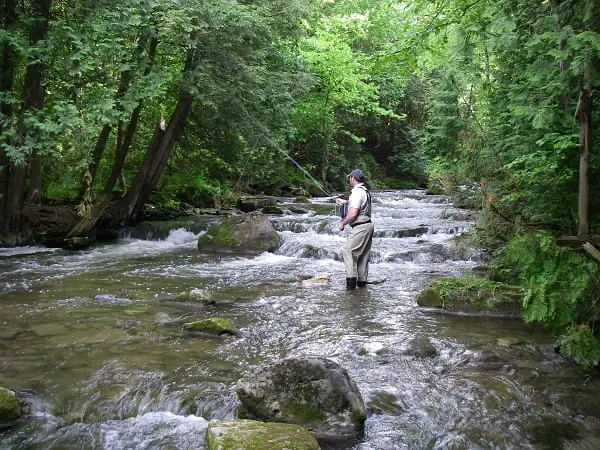Trout Fishing In July: 17 Guide Tips For Hot Weather

Trout fishing in July can be a productive month for trout fishing provided that you use these 11 guide tips and tactics. With a little know-how on how to adapt to the mid-summer river temperatures and bug hatches, trout fishing trips can be as effective as your spring angling adventures.
Benefits Of Trout Fishing In July In Rivers And Streams
- Rivers are far less crowded during July.
- The days are longer so I have more time before and after work. So, even though I need to rise very early to take advantage of the morning feed frenzy, I won’t have to rush home from work and end up fishing in the dark.
- The weather is generally pleasant, especially in the morning when trout fishing is at its best.
How Do High Temperatures Affect July Trout Fishing in Rivers
July is one of the hottest months of the year. In many large cities in the USA, daily temperatures get as high as 80 to 90 degrees Fahrenheit (27 to 32 degrees Celsius).
At the same time, the daily temperature of water in rivers and streams ranges from 65 °F to 75 °F during the day. Some rivers or some parts of rivers will stay colder. Luckily for cold-blooded trout, the water cools down at night.
Trout are generally less active during hot summer days. When water temperature exceeds 65 °F, brook, brown, and rainbow trout feel stressed out. I’ll often continue to fish for brown trout until about 67F without killing them.
The combination of high temp and low flows leaves trout competing for space and food while feeling lethargic at the same time. It is easy to conclude that this is not their favorite time of the year.
Warm water has less oxygen too. For this reason, trout have trouble breathing and have far less energy.
They minimize their activity and feeding times to specific times of the day and they have short feeding windows.
If water temperatures do not drop for a prolonged time, trout can starve, suffer from organ damage, or even die.
As you can see, July trout fishing conditions are rather complex. However, it does not mean you should avoid fishing during these thermally stressful periods.
The Best Tips For Catching Trout In July

I guide all summer, and I routinely catch the same bunch of large 20-plus inch trout over and over again all summer, and I’ll often see these same trout the next year.
This clearly shows that the proper handling and fishing methods that I use and teach work well and that these summer trout don’t just survive being caught in 65F water; the fact that I and my clients catch them and they are even bigger in the fall means they are thriving.
So as long as I am mindful and follow these guidelines, I can still fish trout all summer.
1. Test The Water Temperatures Often

When fishing for trout in July, I always keep an eye on river temperatures and adjust my fishing techniques accordingly.
In the northern climate, air temperatures fluctuate significantly and often range from 50 to 90 on the same day. Water in most trout rivers behaves in the same way except with a little less fluctuation.
Water temperatures can change as much as 12 degrees throughout the day on some of my local spring-fed creaks and tailwater rivers.
I recommend measuring water temperature at least every hour starting around 10 am on hot sunny days.
My best tip is to buy a small pocket stream thermometer and always carry it in your fly pack or vest. Use it to measure the water temperatures before and during fishing.
Note: If I plan to release trout I or my clients catch, fishing at temperatures higher than 70 degrees F becomes unethical since the trout are very likely to die even if I do everything right and handle them minimally.
Generally, trout feed actively when the water temperature is in the 40 – 67 degree range. If the temperature I measure exceeds 67 F, it’s time to change strategies.
2. Find Colder Water
Once the water temps hit 68, I start thinking about finding colder water where trout will still likely be feeding.
Often, the upper sections of rivers tend to stay colder. I also know where there are spring upwelling which keeps the water downriver colder. Spring water tends to be around 55F.
3. Fish Spring Creeks
Spring-fed streams and rivers at higher elevations, especially ones with a lot of shade are my primary choice of location for mid-summer trout fishing. During July, look for trout that prefer moving water and deeper pools in spring creeks.
4. Fish Shaded and Forested Areas

It’s the sun heats up the water, so often, the wide open section of the lower river will heat up faster. If I find a river that has an abundance of natural shade, I’ll be able to stay there even when the air temperature begins to rise.
When fishing trout in July I look for rivers and streams located in forests and valleys that shade most of the stream.
5. Fish Tailwater Rivers
If you are not sure what a tailwater river is, it refers to a section of river below a large damed-up reservoir where the water goes under the dam instead of over the dam.
On some reservoirs, the water above the dam can be 100 feet deep or more, and this deep water stays very cold, or at least cold enough for trout to survive and be active.
Often, 15 to 30 miles below a dam like this will have cold enough water to fish. These are great areas for catching trout in July.
6. Fish Select Spots
High air and water temperatures typical for July drive trout to areas with colder water. A local biologist calls these cool water spots ” a cold water refuge”. Therefore, when midsummer trout fishing, you should look for fish in:
- Fish big deep pools: Big deep pools with some groundwater nearby, can concentrate trout, especially the really big trout.
- Fish rapids: Rapids will stay oxygenated and trout will move into these areas.
- Fish in cold tributaries: Instead of fishing the main river, look for smaller cold-water tributaries. Trout from the main river will move up into these tributaries to wait out the hot weather
- Fish Below Cold Water Tributaries: One of my best-kept secrets is to fish the main river where the cold tributary enters, or fish the first few pools below.
- Waterfalls: Trout that migrate upriver looking for cooler water will get trapped in the plunge pool of waterfalls. This area also has a lot of oxygen.
- Riffles and pocket water: Also a good area due to increased oxygen content.
Since all these mentioned areas are scarce in mid-summer, trout will most likely be grouped in large numbers and thus more susceptible to angling.
7. Fish Early: Fish At Dawn
This is my number one tactic for catching big trout in July.
As we have already established, the best time for mid-summer trout fishing is early in the morning. At first light, the water that has cooled off during the night and trout start feeding actively. It is the most productive part of the day for me and usually lasts on my local river for 3 to 5 hours.
I have seen the river temps go from 75F at 5 pm on hot sunny days to 58F at sunrise and then back up to 70F by noon.
8. Fish At Dusk
If you are not a “rise and shine” kind of person, you can do the opposite and go trout fishing in the evening or even during the night. The darker the night, the better, so it would be best to choose the night of a new moon.
The last few hours before dark, with the lower sun, the river will start to cool to fishable temperatures. Bug activity also increases during this time and so does fish feeding activity.
9. Take Advantage Of Rain And Clouds
Rainy and cloudy days can be the best time to catch trout. There’s no sun to heat up the water and the fishing can stay good all day.
Rain does a few things that improve my chances of catching more and bigger trout. Rain drives insects and food into the rivers and it makes the river murkier. Both of these things will get the trout feeding.
If the rain pours down for a few days, the streams get a supply of fresh water and start pumping it into the rivers. Fresh oxygenated water gets the trout up and running and makes them easier to catch.
Heavy rainfall raises the water levels and stirs the surface of the water. It sets large trout on the feed, too. You should thus consider using larger spinners at such times. After the rain, big trout tend to congregate in shallow areas or open water near undercut banks.
10. Get informed about Hoot Owl Restrictions
Hoot Owl restrictions represent a part of a strategy that aims to help thermally stressed trout in rivers. Numerous state agencies have adopted the proposed rules. So what are they all about?
During hot spells and drought during July and August, trout fishing is not allowed in the afternoon on certain rivers (usually from 2 pm to midnight). It means, fishing is allowed only during the early hours of the day. In this way, trout get to rest while under the most stress. This strategy is most beneficial for catch-and-release angling.
However, the restriction may not be just a time, and the river can be closed to fishing all day or for weeks.
These restrictions are only temporary, and they are taken down as soon as water temperatures return to go back to normal. They should not influence anglers much anyways since they usually practice fishing in the early morning during the warm season.
11. Use longer and thinner leaders.
Trout become more skittish during summer. It has to do with high temperatures and the fact that they have been chased by anglers all spring long. It is inevitable for them to become more cautious and alert.
Consequently, if I want to see some action, I use longer and thinner leaders that won’t spook the fish.
The Best Technique For July Trout Fishing
July tackle tactics do not differ much from those I would use in late spring.
I still use the following methods to catch trout trout in July:
- Float Fishing: Use in sections of the river from 4 to 15 feet deep
- Lure Fishing: Mix it up between large and small lures and dark and bright lures to figure out what the trout want. My tip in clear water is to start with a dark and small lure, and gradually get larger and brighter or flashier.
- Fly Fishing: My go-to method for catching trout in July in the lower clear water is to fly fishing for trout using dry fly, nymphing, or streamer fishing methods.
The Best Baits and Lures for Mid-Summer Trout Fishing
I recommend baiting the hook with a small worm or artificial bait. I recommend maggots, fish egg sacks, or insects. It is important not to overdo it and try small and large baits.
As far as lures are concerned, try one of the following:
- Rooster Tails
- Bang Tails
- FlatFish
- Quick Fish
- Mepps Spinners
- Panther Martins
- Dick Nite Spoons
Tight Lines,
Graham
